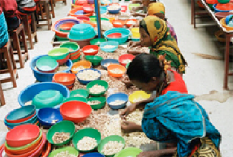
Workers grade cashews in Mtwara, Tanzania: Over $20 billion of IMF allocations of SDRs will go to low-income countries. (photo: Gideon Mendel/Corbis)
The IMF and Civil Society
Low-income countries to benefit from IMF allocation of SDRs
August 31, 2009
The IMF took action to bolster its members’ reserves through an allocation of Special Drawing Rights (SDRs) of about $250 billion. The allocation was made on August 28 and responds directly to the G-20’s call for swift policy action to meet the needs of the developing world.
With the majority of countries struggling to combat the deep global economic downturn, the IMF took action to bolster its members’ reserves through an allocation of SDR equivalent to about $250 billion that will be followed by a smaller allocation of $33 billion on September 9. This means an allocation of more than $20 billion of SDRs to low-income countries (LICs) to bolster their foreign exchange reserves and help alleviate financing constraints due to the global financial crisis and the sharp rise of food and fuel prices in 2007.
The allocation of SDRs boosts member countries’ reserves because SDRs can be turned into usable currencies. Once the SDRs have been added to a member country’s official reserves, the country can voluntarily exchange its SDRs for hard currencies, such as the U.S. dollar, euro, yen, or pound sterling, through voluntary trading arrangements with other IMF member countries. Some countries have already volunteered to set up trading arrangements that will facilitate the buying and selling of SDRs. The allocation is distributed to all member countries according to their quotas in the IMF.
Addressing LICs’ higher financing needs
About $110 billion of the combined allocations will go to emerging market and developing countries, including over $20 billion to low-income countries. Many of these countries currently face difficult spending decisions as they decide how to address the fallout from the global crisis. For them, the SDR allocation means potential access to unconditional financial resources that could limit the need for adjustment through contractionary policies and allow greater scope for countercyclical policies in the face of recession and rising unemployment.
“The general SDR allocation is a key part of our response to the global crisis, demonstrating the value of a cooperative multilateral approach,” IMF External Relations Director Caroline Atkinson said. “The Fund’s low-income members will benefit significantly,” she added. Despite a smaller number of SDRs going to the IMF’s low-income members, the allocation will result—in most cases—in a proportionately bigger increase in reserves for them than it will for the advanced economies, which already have a substantial cushion of reserves.
SDR allocation responds to G-20’s call
It was at its April summit in London that the Group of Twenty (G-20) industrial and emerging market countries called for an SDR allocation of $250 billion. The proposed general allocation was approved by the IMF’s Board of Governors on August 7, 2009, and came into effect on August 28. The allocation is based on a long-term global need to supplement IMF members’ existing reserve assets and it provides liquidity to the global economic system.
The G-20 had also called for urgent ratification of a long-pending amendment to the IMF’s Articles of Agreement. This so-called Fourth Amendment was proposed to enable all Fund members to participate in the SDR system on an equitable basis and correct for the fact that countries that joined the Fund after 1981—now more than one-fifth of the current IMF membership—have never received an SDR allocation.
The amendment to the Articles had originally been set in motion over ten years ago, but it needed to then pass successfully through the legislatures of three-fifths of the Fund’s members, having 85 percent of the total voting power. Recently amended U.S. legislation paved the way for making the amendment effective in August. The amendment provides for a special one-time allocation that will be separate and additional to any SDRs allocated to members under the general allocation of SDRs.
Mechanics of SDR allocations
General allocations of SDRs are made as a percentage of a member’s quota with all participants receiving the same percentage—a member’s quota is based broadly on its relative size in the world economy and determines both its subscription to the capital of the IMF and voting rights in the organization; a member’s quota has a bearing on its access to IMF financing. Allocations under the special amendment to the Articles of Agreement would not be made in proportion to quotas but rather pursuant to a methodology that would bring participants’ net cumulative allocations-to-quota ratio to a specific common benchmark. SDR allocations provide each member with a costless asset. If a member’s SDR holdings rise above its allocation (for example, if it purchases SDRs from another member), it earns interest on the excess; on the other hand, if it holds fewer SDRs than allocated, it pays interest on the shortfall at the official SDR interest rate.
